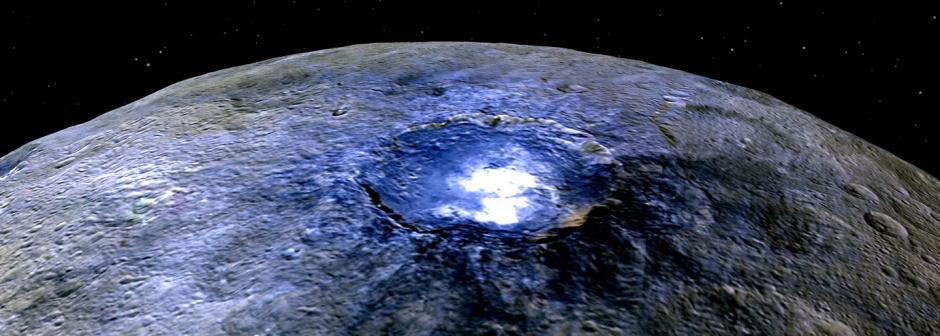PROVIDENCE, R.I. [Brown University] — The mysterious dwarf planet Ceres is starting to spill its secrets, and Brown geologist Carle Pieters is helping to unravel them.
Pieters is a co-investigator on NASA’s Dawn mission, which is now reaching its lowest orbit above Ceres, just 374 km above surface. As Dawn descends, mission scientists are still analyzing data collected during the approach and high-orbit phases of the mission. Pieters is a co-author of two papers published today in the journal Nature that outline some of those initial findings.
“This is an exciting time in the mission when we really start to dig into the data,” Pieters said. “We’re learning a lot, but there’s still so much about Ceres that has our heads spinning.”
One of those papers describes findings from Dawn’s Visible and Infrared Spectrometer, which has been analyzing the bulk composition of Ceres’ surface. The findings give clues — and raise significant questions — about the dwarf planet’s origins.
The analysis showed that Ceres surface appears to be rich in ammonia-rich clays. Before the Dawn mission, Earth-based spectrometers had suggested that there were hydrated minerals on Ceres’ surface, but a key portion of the light reflected from Ceres was blocked by Earth’s atmosphere. As a result, it wasn’t clear if those hydrated minerals were in the form of water, ammonia or a magnesium-based compound called brucite.
“With Dawn we can finally get a look at the full spectrum,” Pieters said. “With the fitting we’ve been able to do so far, it looks like ammonia-bearing species are clearly most consistent with the new Dawn data.”
The presence of ammonia has significant implications for Ceres’ origin, and raises questions about how it came to exist in the asteroid belt between Mars and Jupiter.
“When we look at the models of the early solar system, we expect ammonia to condense much farther out — in the area of the gas giants,” Pieters said. “So the question is: How in the heck did Ceres get ammoniated material in the asteroid belt?”
One possibility is that Ceres accumulated small debris that drifts in from the outer solar system, and retained the ammonia component. But that scenario raises the question of why Ceres got all this material and not the rest of the asteroid belt objects.
Another possibility is that Ceres originally accreted from tiny pebbles of ammoniated material that swept in from farther out in the solar system during early phases of accretion. Or it could be that Ceres formed en masse farther out, and then moved into the asteroid belt during the early migration of the planets.
The Dawn team hopes the additional data they’re collecting now might help to illuminate these and other possibilities for Ceres’ origin.
Meanwhile, the second paper published today offers a clue about mysterious bright spots first imaged by Dawn during its approach.
“Ceres itself is very dark. It’s one of the darkest asteroids visited,” Pieters said. “But these spots were much, much brighter than everything else on the surface.”
The analysis suggests that the spots are deposits of salt. But it’s not entirely clear yet how the deposits got there. One possibility is that an impact dredged up a briny mixture of salt and water ice from Ceres’ subsurface. As the ice sublimated away, the salt deposits were left behind.
That’s a viable hypothesis, Pieters says, but analysis of more spectroscopic data is needed to find a definitive answer.
Dawn is gathering new data right now. Now that the spacecraft has reached its lowest orbit, it can gather much higher resolution images of surface features. Scientists will now be able to use an instrument in Dawn’s payload that hasn’t been used at Ceres yet — the neutron and gamma ray spectrometer.
“These combined instruments let us evaluate the chemistry of Ceres and test current hypotheses,” Pieters said. “We’ll learn a lot more in the coming months. It’s going to be exciting.”

